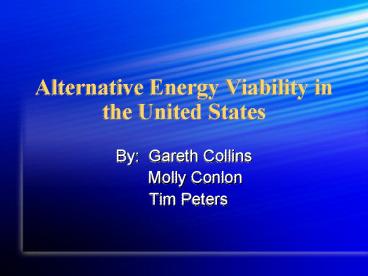Alternative Energy Viability in the United States - PowerPoint PPT Presentation
1 / 21
Title:
Alternative Energy Viability in the United States
Description:
If the United States adopts efficient modes of alternative energy use, we can ... 'Wind Energy Resource Atlas of the United States. ... – PowerPoint PPT presentation
Number of Views:94
Avg rating:3.0/5.0
Title: Alternative Energy Viability in the United States
1
Alternative Energy Viability in the United States
- By Gareth Collins
- Molly Conlon
- Tim Peters
2
Table of Contents
- Hypothesis / Intro
- Alternative Energy Types
- Environmental Impacts
- Conclusion
- Bibliography
3
Hypothesis
- If the United States adopts efficient modes of
alternative energy use, we can mitigate the
global rise in Carbon Dioxide emissions and
environmental hazards.
4
Introduction
- The bulk of our research is focused on three
viable forms of energy that will effectively
reduce carbon emissions in the United States
Nuclear, Wind, Biomass
5
Background Information
- Major sources of energy in the United States
include and their effects on the environment - Coal (51)
- Nuclear (20)
- Natural Gas (17)
- Hydro (7)
- Petroleum (3)
- Renewables/other (2)
6
Fossil Fuels Coal, Petroleum, Natural Gas
- Advantages
- Good availability presently
- Simple combustion
- Inexpensive
- Easily distributed
- Disadvantages
- Contributor to global warming
- Exhaustible fuel source
- Cause of acid rain
7
Nuclear Energy
- Advantages
- Same cost as coal
- No pollution
- Small amount of fuel needed for large amount of
energy production - Small amount of waste
- Reliable
- Disadvantages
- Very dangerous
- Money must be spent on safety
8
Nuclear Fission
- Currently 103 operational reactors in U.S.
- Does not produce smoke or carbon dioxide, so it
does not contribute to the greenhouse effect. - Offsets 700 million metric tons of CO2 per year
in the U.S. (2 billion worldwide).
9
(No Transcript)
10
Biomass Energy
- Advantages
- Inexhaustible
- Minimal environmental impact
- Globally available
- Disadvantages
- Could contribute to increased CO2 emissions if
burned directly - Expensive source
11
Biomass
- Pure ethanol is used in approximately 40 of the
cars in Brazil. - Brazil consumes nearly 4 billion gallons of
ethanol annually. - Adapting cars to pure ethanol is relatively
inexpensive.
12
Ethanol Production Process
13
Wind Energy
- Advantages
- Inexhaustible
- No pollution
- Disadvantages
- Disperse source (low energy production)
- Geographically dependent
- Expensive to maintain
14
Wind Energy
- Wind energy is the cheapest form of alternative
energy. - With reasonably aggressive expansion of wind
power, the Midwest United States could easily
supply 5-10 of its power needs with wind
generators.
15
-The darker areas indicate higher amount of
natural wind energy.
16
Environmental Impacts
- Tropical storms have become more powerful with
increased global temperatures. - Climate may cause species to migrate out of
protected areas. - Higher temperatures increase disease and invasive
species.
17
Stella Models
- Global carbon emissions if the U.S. maintains its
current level of carbon emissions.
- Global carbon emission if the U.S. reduces its
carbon emission by 50 over 100 years.
18
Conclusions
- Alternative energy is increasingly viable and
necessary. - Large scale change in the US will yield modest
results in the global climate picture, and will
set a precedent for further global change. - Significant environmental impacts can be
mitigated by human action.
19
Take-Home Message
- The United States, as the worlds leading Carbon
Dioxide emitter, has a responsibility to embrace
alternative energy. - We are already feeling the effects of climate
change, the time to act is now.
20
Bibliography
- Mynick, H. E., D. O. Hall, and R. H. Williams.
"Cooling the Greenhouse with Bioenergy." Nature
353 (1991). 21 Nov. 2006 /energy/publications/pdf/1991/Williams_91_Cooling
_the_Greenhouse.pdf - Emanuel, Kerry. 2005. Increasing destructiveness
of tropical cyclones over the last 30 years.
Nature, 436 686-688. - Loiter, Jeffrey M. Technology Policy and
Renewable Energy Public Roles in the Development
of New Technologies. Energy Policy 27 (1999)
85-97. - Soholt, Beth. Wind Power Development Progress
and Challenges. (2005)Search Tools. U of
Michigan Lib., Ann Arbor. 23 Oct. 2006.
http//searchtools.lib.umich.edu
21
Bibliography Continued
- "Wind Energy Resource Atlas of the United
States." 3 Dec. 2006 ubs/atlas/maps/chap2/2-01m.html. - "The Economics of Nuclear Power." Uranium
Information Centre. Nov. 2006. 1 Dec. 2006
. - "Environment Emissions Prevented." Nuclear
Energy Institute. 1 Dec. 2006 index.asp?catnum2catid346. - "BIOMASS ETHANOL Technical Progress,
Opportunities, and Commercial Chal." Annual
Review of Energy and the Environment 24 (1999)
189-226. 21 Nov. 2006 iews.org/doi/full/10.1146/annurev.energy.24.1.189?
cookieSet1.































